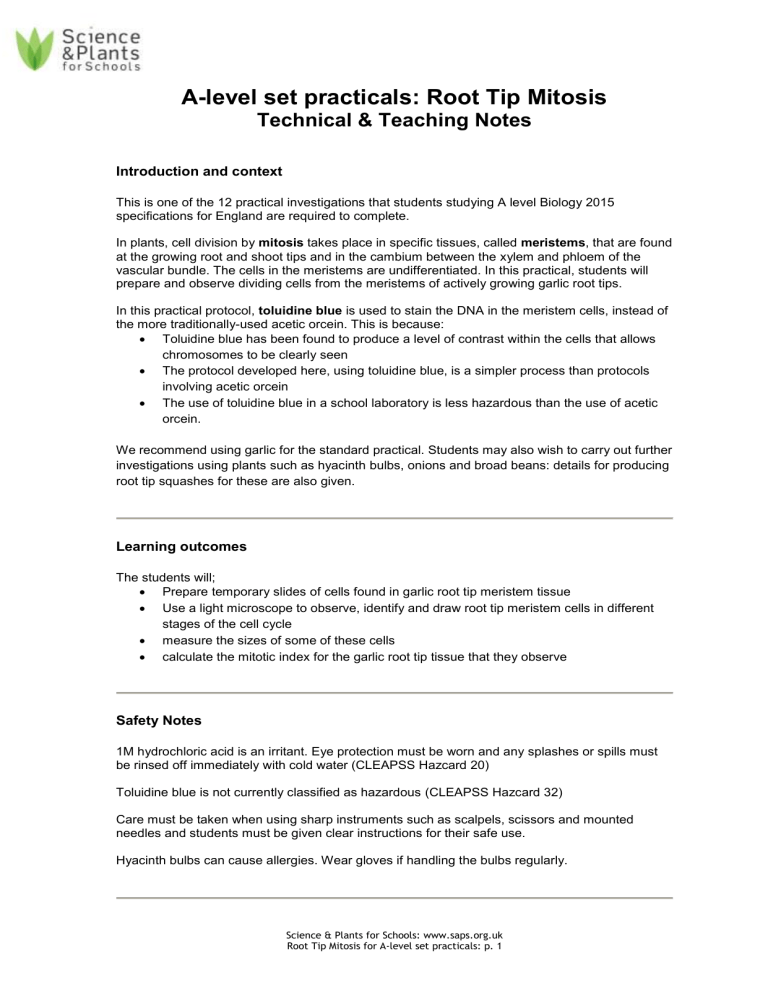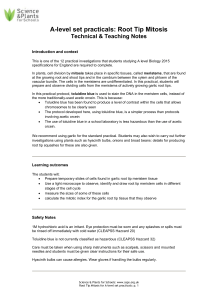
A-level set practicals: Root Tip Mitosis Technical & Teaching Notes Introduction and context This is one of the 12 practical investigations that students studying A level Biology 2015 specifications for England are required to complete. In plants, cell division by mitosis takes place in specific tissues, called meristems, that are found at the growing root and shoot tips and in the cambium between the xylem and phloem of the vascular bundle. The cells in the meristems are undifferentiated. In this practical, students will prepare and observe dividing cells from the meristems of actively growing garlic root tips. In this practical protocol, toluidine blue is used to stain the DNA in the meristem cells, instead of the more traditionally-used acetic orcein. This is because: Toluidine blue has been found to produce a level of contrast within the cells that allows chromosomes to be clearly seen The protocol developed here, using toluidine blue, is a simpler process than protocols involving acetic orcein The use of toluidine blue in a school laboratory is less hazardous than the use of acetic orcein. We recommend using garlic for the standard practical. Students may also wish to carry out further investigations using plants such as hyacinth bulbs, onions and broad beans: details for producing root tip squashes for these are also given. Learning outcomes The students will; Prepare temporary slides of cells found in garlic root tip meristem tissue Use a light microscope to observe, identify and draw root tip meristem cells in different stages of the cell cycle measure the sizes of some of these cells calculate the mitotic index for the garlic root tip tissue that they observe Safety Notes 1M hydrochloric acid is an irritant. Eye protection must be worn and any splashes or spills must be rinsed off immediately with cold water (CLEAPSS Hazcard 20) Toluidine blue is not currently classified as hazardous (CLEAPSS Hazcard 32) Care must be taken when using sharp instruments such as scalpels, scissors and mounted needles and students must be given clear instructions for their safe use. Hyacinth bulbs can cause allergies. Wear gloves if handling the bulbs regularly. Science & Plants for Schools: www.saps.org.uk Root Tip Mitosis for A-level set practicals: p. 1 Apparatus Per student: Eye protection Protective gloves 250cm3 beaker 2 x bijou bottles or similar vials large enough to hold a growing garlic clove 100cm3 bottle of 1M hydrochloric acid 3 x 3cm3 plastic pipettes 3-day old rooted garlic clove, suspended over water with a cocktail stick – see later for guidance Cutting tile Paint brush 250cm3 beaker containing tap water (for rinsing) Dropping bottle of 1% toluidine blue stain Dissection scissors Microscope slide plus access to spare Cover slip plus access to spare Mounted needle Paper towels Compound light microscope (100-400X magnification) Eyepiece graticule Timer/stop clock Per class: Water bath at 40oC Stage micrometer Apparatus for Further Investigations Apparatus list as per the root tip mitosis practical, plus: Rooted hyacinth bulbs (See guidance notes on use of hyacinth bulbs in section ‘Using Hyacinth roots to prepare root tip squashes’ Rooted onion bulbs Rooted broad beans Garlic cloves rooted for differing amounts of time or at different temperatures Technical guidance Using garlic roots to prepare root tip squashes http://www.saps.org.uk/secondary/teaching-resources/752-using-garlic-in-the-lab Garlic cloves, bought normally for cooking purposes, will produce roots at any time of year. Use a garlic clove that has been growing for three days and has roots that are about 1cm long. As the growth rate of the roots is very variable, it is advisable to have rooted cloves available that are older or younger than 3 days old. The garlic clove can be suspended over water, using a cocktail stick, as illustrated. Using cocktail sticks to hold the garlic enables the roots to be left intact for the majority of the treatments, minimising the handling of HCl and enabling easy rinsing of the roots. The cell cycle is thought to be influenced by the plant’s circadian clock, so it is suggested that active cell division is most likely to be observed in the morning or around mid-day * Science & Plants for Schools: www.saps.org.uk Root Tip Mitosis for A-level set practicals: p. 2 If you have several groups and only a few rooted garlic cloves, you can split the cloves of garlic in half, so one clove can be used for two groups. Using a scalpel or sharp knife, carefully split the clove longitudinally. NB, each student needs at least 3 roots. As an extension activity, students may wish to investigate the effect of age of the roots or the temperature at which the roots are grown, on the mitotic index, Using broad bean roots to prepare root tip squashes Advice from Practical Advanced Biology. King, Reiss, Roberts; Germinate the broad beans on blotting paper 10 days before the laboratory session. When the radicle is 12mm long, cut off its tip to stimulate the growth of lateral roots. Using hyacinth roots to prepare root tip squashes Hyacinth bulbs can cause allergies. Wear gloves if handling the bulbs regularly. Hyacinth bulbs can be bought at garden centres during autumn and winter. To prepare hyacinth bulb roots, place the bulb in a suitably sized container with water so that the root end is just in contact with the water. Change the water daily if possible. Roots of a suitable length (2-6 cm) will be available within a week and perhaps sooner. Using onion roots to prepare root tip squashes Use an onion bulb that has been growing over water for three days and has roots that are about 1cm long. Using toluidine blue stain The toluidine blue is made up as a 1% solution in distilled water. 0.5g in 50cm3 distilled water will provide enough stain for a class practical. Toluidine blue is not currently classified as hazardous (CLEAPSS Hazcard 32) Suppliers Toluidine blue: available from standard school suppliers such as Timstar, Phillip Harris. e.g. Phillip Harris 5g for £17.99 Garlic: Available from greengrocers and supermarkets. Organic garlic is preferred (but not essential), as it is less likely to have been treated to stop the garlic from growing whilst in storage. Teaching Notes Preparation tasks 1. Use the SAPS animation ‘Growth in Plants’ to introduce the location of plant meristems and the cell division occurring within them. (http://www.saps.org.uk/secondary/themes/1290). This includes accompanying notes to support students and teachers. 2. The accompanying student preparation sheet (http://www.saps.org.uk/secondary/teachingresources/1358) can be used to prepare the students for the practical and to support their subject knowledge throughout the practical. 3. The accompanying PowerPoint presentation (http://www.saps.org.uk/secondary/teachingresources/1358) can be used to clarify the practical protocol and to provide supporting images. Science & Plants for Schools: www.saps.org.uk Root Tip Mitosis for A-level set practicals: p. 3 Answers to questions on student protocol street 1. Explain why root tips are used in this investigation. In plants, cell division by mitosis is restricted to specific tissues, called meristems, that are found at the growing root and shoot tips and in the cambium between the xylem and phloem of the vascular bundle. The cells in the meristems are undifferentiated. This practical involves the preparation and observation of dividing cells from the meristems of actively growing garlic root tips. 2. Why are you using several roots? The roots become very delicate during the preparation stage and may decompose. Using several roots increases the likelihood that one root tip will survive to give a good root tip squash. 3. Why are the root tips placed in IM hydrochloric acid at 40oC for 5 minutes? The cellulose cell walls of one plant cell are ‘cemented’ to those of adjacent cells by the middle lamella, that contains pectin. The acid hydrolyses the middle lamella, allowing the stain to diffuse into the cells and enabling the tissue to be squashed into a layer one cell thick Heating the acid to 40 oC increases the rate of hydrolysis of the middle lamella. 4. Why are the root tips placed in toluidine blue stain for 2 minutes? The toluidine blue stain binds to chromatin DNA, staining it deep blue and making the chromosomes visible. Staining for two minutes allows the stained chromosomes to be clearly defined. 5. Why are the root tips gently squashed? To produce a layer that is one cell thick. This prevents one layer of cells from lying on top of another, obscuring the view of the chromosomes. The root tip squash is performed gently so that the cells are not ruptured and to prevent the microscope slide and coverslip from cracking. 6. How could you increase the reliability of estimates of cell size? Measure several cells at the same stage in the same field of view and calculate the mean size for that stage. Use the same parameter when measuring e.g. top to bottom of a cell, along the long axis of a column of cells. 7. How could you modify the protocol to improve the definition of the chromosomes within the cells? Answers could include increasing the time spent in HCl, increasing the temperature at which the root tips are incubated in the HCl, increasing the time spent in stain, increasing the temperature at which staining takes place. 8. The mitotic index is a quantitative expression of the amount of cell division that a tissue is undergoing. Compare the mitotic index for cells in the root tips of your garlic clove with the mitotic index obtained by other students in your class, using different garlic cloves. a. Discuss the possible causes of (i) similarities in mitotic indices Same species of garlic, cloves from the same bulb, grown for the same amount of time, under the same specifically named conditions e.g. light regime, intensity, temperature, prior to the experiment (ii) differences in mitotic indices within the class Environmental gradient in the place where the cloves were grown, grown for different lengths of time, quality of root tip squash leading to difficulty in observing chromosomes in cells, health of the garlic clove tissue affecting root growth, cloves from several different bulbs which may come from a variety of different species. b. How might a mitotic index be used in the study and treatment of cancer? It could be used to provide information about how much cell division is taking place within a tumour and therefore how rapidly it is growing. Science & Plants for Schools: www.saps.org.uk Root Tip Mitosis for A-level set practicals: p. 4 9. As your slide is a snap-shot of the cell division occurring in the root tip meristem at one moment, what do the percentages that you calculated in step 20 suggest about the length of time that the root tip meristem cells spend in each stage of the cell cycle? Explain your answer. There will be many cells observed in the stages of the cell cycle that take a long time, giving high percentages. The root tip squashes will contain few cells in the stages of the cell cycle that occur rapidly, giving low percentages. Getting learning value from the practical Practical skill development Extension to practical skill development Maths skill development Extension to maths skills development Associated subject knowledge development Recording evidence of student’s work Meeting aspects of the use of apparatus and techniques Meeting aspects of the CPAC Developing knowledge and understanding of the techniques and procedures for staining chromosomes. Using microscopes (including the use of an eyepiece graticule and a stage micrometer). Application of knowledge to use these techniques to identify stages of mitosis in tissue being observed. Planning and carrying out an investigation into the effect of a named variable on the mitotic index of root tip meristem tissue. Calculation of mitotic index Calculation of actual size of cells Calculation of relative length of stages of the cell cycle Application of knowledge of mitosis and the cell cycle to identify cells in different stages of mitosis. Use of measured values to calculate the actual size of cells. Understanding of what the mitotic index is and how to calculate it from observed values. Completion of student practical worksheet, including drawing of observed cells, calculation of mitotic index, measuring the size of the cells and answering the questions on the sheet. https://www.gov.uk/government/uploads/system/uploads/attachment_data/fil e/447147/2015-07-20-gce-subject-level-conditions-and-requirements-forscience-and-certificate-requirements.pdf use of light microscope at high power and low power, including use of a graticule produce scientific drawing from observation with annotations use qualitative reagents to identify biological molecules safely use instruments for dissection of an animal organ, or plant organ https://www.gov.uk/government/uploads/system/uploads/attachment_data/fil e/447147/2015-07-20-gce-subject-level-conditions-and-requirements-forscience-and-certificate-requirements.pdf Use and apply scientific methods and practices safely and correctly use a range of practical equipment and materials follow written instructions make and record observations keep appropriate records of experimental activities present information and data in a scientific way use appropriate software and tools to process data, carry out research and report findings Science & Plants for Schools: www.saps.org.uk Root Tip Mitosis for A-level set practicals: p. 5 Sample data This image can be used to calculate the mitotic index for garlic root tip tissue. Further Investigations Students could plan their own investigation into the effect of a named variable on the mitotic index of root tip meristem tissue. Variables that could be investigated include: The temperature at which the garlic cloves were rooted The length of time for which the garlic cloves were rooted The plant species being investigated. Garlic is very reliable, but cell division in root tip meristems of onions, hyacinths and broad beans can also be observed using this protocol: information on growing these is given above. Science & Plants for Schools: www.saps.org.uk Root Tip Mitosis for A-level set practicals: p. 6 References Ofqual https://www.gov.uk/government/uploads/system/uploads/attachment_data/file/447147/2015-0720-gce-subject-level-conditions-and-requirements-for-science-and-certificate-requirements.pdf SAPS animations Use the SAPS animation ‘Growth in Plants’ to introduce students to the location of plant meristems and the processes occurring within them. http://www.saps.org.uk/secondary/themes/1290 CLEAPSS Hazcards http://www.cleapss.org.uk/ Log-in required Acknowledgements With thanks to Gail Webdell, University of Cambridge Science Education Department, Homerton College, Cambridge; the delegates at the SAPS ‘Train the Trainers’ session, November 2015; Leighton Dann for initial work on this protocol; Kev Hall, Science Technician, West Derby School, Liverpool; and the Year 12 A level Biology students of West Derby School, Liverpool. Image of mitosis taken by delegates on the SAPS ‘Train the Trainers’ session, November 2015. This resource was developed by Beverley Goodger, West Derby School, Liverpool. Science & Plants for Schools: www.saps.org.uk Root Tip Mitosis for A-level set practicals: p. 7


